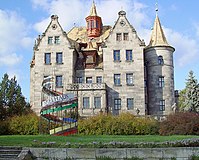Rudolstadt
Rudolstadt | |
|---|---|
 | |
 Coat of arms | |
show Location of Rudolstadt within Saalfeld-Rudolstadt district | |
 Rudolstadt | |
| Coordinates: 50°43′1″N 11°19′39″E / 50.71694°N 11.32750°ECoordinates: 50°43′1″N 11°19′39″E / 50.71694°N 11.32750°E | |
| Country | Germany |
| State | Thuringia |
| District | Saalfeld-Rudolstadt |
| Subdivisions | 12 |
| Government | |
| • Mayor (2018–24) | Jörg Reichl[1] |
| Area | |
| • Total | 135.17 km2 (52.19 sq mi) |
| Elevation | 195 m (640 ft) |
| Population (2020-12-31)[2] | |
| • Total | 24,672 |
| • Density | 180/km2 (470/sq mi) |
| Time zone | UTC+01:00 (CET) |
| • Summer (DST) | UTC+02:00 (CEST) |
| Postal codes | 07407 |
| Dialling codes | 03672 |
| Vehicle registration | SLF, RU |
| Website | www.rudolstadt.de |
Rudolstadt is a town in the German federal state Thuringia, with the Thuringian Forest to the southwest, and to Jena and Weimar to the north.
The former capital of Schwarzburg-Rudolstadt, the town is built along the River Saale inside a wide valley surrounded by woods. Rudolstadt was founded in 776 and has had municipal law since 1326. The town's landmark is the Castle Heidecksburg which is enthroned on a hill above the old town. The former municipality Remda-Teichel was merged into Rudolstadt in January 2019.
Rudolstadt was once well known because of the Anchor Stone Blocks of the Toy Company Richter and porcelain factories, beginning with the establishment of the Volkstedt porcelain manufacture in 1762.
History[]
Early History[]
There is archeological evidence of a hill fort on the Weinberg in Oberpreilipp from the time of the late Urnfield culture and the early Iron Age.[3] A Celtic settlement followed the Germanic one and the affiliation with the Duchy of Thuringia. From the 6th Century onwards, archeological records suggest Slavic settlement in the area.
The first documented mention of the placename was in 776 as Rudolfestat (Rudolf's settlement) as a gift from Charlemagne to Hersfeld Abbey[4]
Historical Population[]

Number of Inhabitants (from 1960 as of 31 December, unless otherwise indicated):
|
1834 to 1960
|
1970 to 1997
|
1998 to 2005
|
2006 to 2013
|
since 2014
|
- Data since 1994: Thuringian Statistical Office
1 29 October
2 31 August
Culture[]
Rudolstadt hosts Germany's biggest folk, roots, and world music festival, TFF Rudolstadt (Tanz&FolkFest), taking place annually on the first full July weekend.[5]
Rudolstadt is twinned with Letterkenny, Co. Donegal, Ireland.[6]
Since 2012 Rudolstadt hosts Getting tough race (German wiki), Europe's hardest obstacle race.
Economy[]
The headquarters of the EPC Group, a global engineering and construction company, are in Rudolstadt.

The so-called "Richtersche Villa" (Richters Mansion).

Rudolstadt Town Hall

Bobo 2006
Notable people from Rudolstadt[]
- Hans Fallada, German writer. He went to school in Rudolstadt, it was here that he killed his friend Hans Dietrich von Necker in a duel.
- Simone Lange, German politician (SPD)
- Charlotte von Lengefeld (1766-1826), wife of Schiller
- Franz Liszt, Hungarian composer worked here as the composer in residence for the Rudolstadt theatre
- Richard Wagner, German composer, worked here as the composer in residence for the Rudolstadt theatre
- Niccolò Paganini, Italian composer, worked here as the composer in residence for the Rudolstadt theatre
- Philipp Heinrich Erlebach, German composer and choirmaster in Rudolstadt
- Ahasverus Fritsch, German poet and composer
- Princess Anna Sophie of Schwarzburg-Rudolstadt, grandmother of King Leopold I of Belgium, great-grandmother to Albert, Prince Consort of the United Kingdom
References[]
- ^ Gewählte Bürgermeister - aktuelle Landesübersicht, Freistaat Thüringen, accessed 14 July 2021.
- ^ "Bevölkerung der Gemeinden, erfüllenden Gemeinden und Verwaltungsgemeinschaften in Thüringen Gebietsstand: 31.12.2020". Thüringer Landesamt für Statistik (in German). June 2021.
- ^ Michael Köhler: Thüringer Burgen und befestigte vor- und frühgeschichtliche Wohnplätze. Jenzig-Verlag Köhler, Jena 2001, ISBN 3-910141-43-9, S. 270.
- ^ Wolfgang Kahl, Hansjürgen Müllerott (2002), Die Vor- und Frühgeschichte Rudolstadts mit den Annalen von 775–786 bis 1503 und einem Exkurs aus der Geschichte Saalfelds (in German), Arnstadt: Thüringer-Chronik-Verlag H. E. Müllerott, p. 128, ISBN 3-910132-73-1
- ^ Official website of TFF.Rudolstadt Archived 2006-02-04 at the Wayback Machine
- ^ "Donegal Councillor Ian McGarvey immortalised in wine". Donegal News. 29 March 2019. Archived from the original on 30 March 2019.
External links[]
 Media related to Rudolstadt at Wikimedia Commons
Media related to Rudolstadt at Wikimedia Commons- Official website
 (in German)
(in German)
- Towns in Thuringia
- Rudolstadt
- 776 establishments
- Bezirk Gera
- Populated places established in the 8th century
- Saalfeld-Rudolstadt
- Schwarzburg-Rudolstadt





